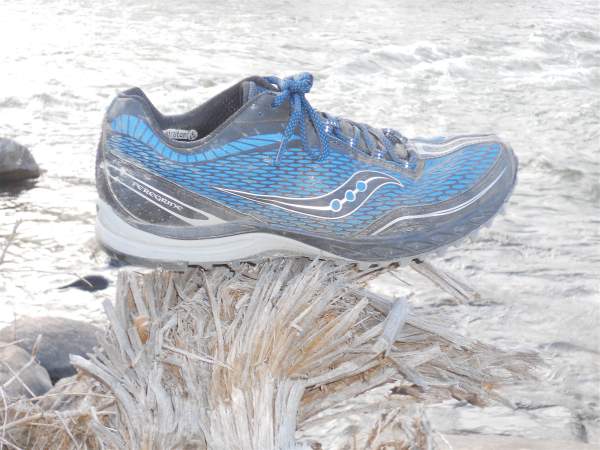For the latest on the Saucony Peregrine, check out our Saucony Peregrine 15 review.
Our Favorite Trail Running Shoes
Check out our Best Trail Running Shoes article to learn about our current favorite trail running shoes!
Saucony Peregrine Review
Saucony has re-tooled much of its running shoe line after the success of last year’s Kinvara (iRF review), which has helped many runners move more towards a more minimalist style that doesn’t leave them hobbling. The Saucony Peregrine has had quite a bit of attention already this winter as a rugged and almost minimalist trail shoe with a low heel drop. Saucony utilized the popular last and heel drop of the Kinvara (and new Mirage model) to create a 10.1 ounce (US men’s 9.5) race ready shoe that feels rugged and supportive enough for ultra distances. As I put this shoe through the paces on a variety of surfaces and will share with you my thoughts on the upper, midsole, and outsole, as well as its overall performance.
Saucony Peregrine Upper
The Peregrine’s upper features a closed mesh synthetic upper with a synthetic leather webbing that provides protection from the elements and support. Saucony chose to go with oval laces as well as a gussetted tongue that kept debris out of the shoes during even muddy runs. The heel collar is well padded and rides well below the ankle to reduce irritation and improve mobility. The shoe gives you that “locked down” feeling that is a must have for trail shoes. This upper errs neither on the side of minimalist nor built up. It sits right in the middle of the spectrum of functionality. In the past, especially with their road shoes, Saucony constructed the toe box of their shoes in a very shallow fashion, meaning that one’s toes could not wiggle up at all without encountering resistance from the upper. At times this was accompanied by very tapered lasts on the shoes that made for a somewhat narrow and shallow toe box. For this reason, I was unable to wear Saucony shoes successfully in the past. However, the Kinvara changed all of that and the Peregrines sport a deeper and wider toe box that accommodated my average width feet quite well and left my toes room to splay a bit as they would in natural running. On runs above 70 degrees I did feel like my feet were a little warm even when wearing very thin running socks. Conversely, they did protect very well from snow, slush, and mud.
Saucony Peregrine Midsole
The Peregrine features the same 4mm heel drop as the Kinvara (18mm heel to 14mm toe). This low drop makes the shoe very agile on technical trail. The midsole also has a good amount of adequately firm cushioning from heel to forefoot that kept my feet protected for the long haul. Saucony uses the same ProGrid lite foam in the heel and SSL (Saucony Super Lite) foam in the forefoot. Support comes in the form of an “external bedrock outsole” which not only protects the foot and acts as a rockplate, but also lends itself to providing some medial support for mild to moderate pronators.
Saucony Peregrine Outsole
The Peregrine’s outsole features aggressive lugs and ridges made of a durable carbon rubber compound that felt very grippy over rocks and on muddy trail. This outsole material is harder, and more durable, than most of the shoes I test but it melded nicely with the cushioning to provide an agile transition and fully conceptualized ride. The only drawback I found to having this aggressive outsole was that it picked up a good deal mud and clay that was difficult to shed during the run.
Saucony Peregrine Performance
Already the Peregrine has received praises for showing versatility and moderation in a trail shoe market that is currently polarized between very minimalist and overbuilt trail shoes. I was very impressed with this shoe right out of box and my satisfaction with this shoe only grew the more I ran in it. The Peregrine feels minimal, light, and flexible, yet it is also protective and supportive enough to wear on gnarly trails for long training runs and ultras. For runners looking to transition into a more minimalist trail shoe, or a trail racer, the Peregrine will be a great match. Other runners who feel that their feet are getting beat up in more minimalist shoes should be able to wear the Peregrine for ultra-distances without the same wear and tear on their feet. This shoe will accommodate mild to moderate pronators but retains the flexibility needed for technical trail running.
Editor’s Addition
Bryon Powell here. Over the past month, I’ve run in the Peregrine in Death Valley, over the redrock of Utah’s southern deserts, and in snowy Park City. Straight out of the box these felt great and they’ve only gotten better. I love the light and racey feel of a shoe that provides me with plenty of support. Due to some long term injuries and imbalances, I’m not generally a fan of shoes with such a low heel-toe drop; however, I had a great, issue-free 13 mile singletrack and slickrock this past week. While I’ll have to see how I fare with the lower drop over longer distances, the Peregrine currently has a strong number seeding as my shoe for the Western States 100. This is a shoe that will surprise many trail runners and that will make big waves this year. It’s very early, but I’ll call this versatile speedster a front runner for trail running shoe of the year.
Call for Comments
If any of you have worn this shoe, what did you think? Got any questions? Well, ask ’em!




